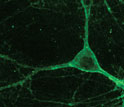News Release 10-001
Silencing Brain Cells with Yellow and Blue Light
New tools use light to turn off brain cells and possibly treat brain disorders

Turning off brain cells with colored light may lead to treatments for Parkinson's disease.
January 6, 2010
View a view interview (clip1, clip2, clip3, clip4, clip5) with Edward Boyden of MIT.
This material is available primarily for archival purposes. Telephone numbers or other contact information may be out of date; please see current contact information at media contacts.
Neuroscientists at the Massachusetts Institute of Technology have developed a powerful new class of tools to reversibly shut down brain activity using different colors of light. When targeted to specific neurons, they could potentially lead to new treatments for abnormal brain activity associated with disorders including chronic pain, epilepsy, brain injury and Parkinson's disease.
Such disorders could best be treated by silencing, rather than stimulating abnormal brain activity. These new tools, or ‘super silencers,' exert exquisite control over the timing in which overactive neural circuits are shut down--an effect that is not possible with existing drugs or other conventional therapies.
The National Science Foundation's division of mathematical sciences supports the research through a grant to the Cognitive Rhythms Collaborative, which is comprised of four research groups in the Boston area focused on questions in neuroscience. The collaborative brings together researchers with expertise ranging from experimental design to mathematical modeling. The research paper, "High-Performance Genetically-Targetable Optical Neural Silencing by Light-Driven Proton Pumps," appears in the Jan. 7 issue of the journal Nature.
"Silencing different sets of neurons with different colors of light allows us to understand how they work together to implement brain functions," explains Ed Boyden, senior author of the study. "Using these new tools, we can look at two neural pathways and study how they compute together," he says.
The tools promise to help researchers understand how to control neural circuits, leading to new understandings and treatments for brain disorders. Boyden, the Benesse Career Development Professor in the MIT Media Lab and an associate member of the McGovern Institute for Brain Research at MIT, calls brain disorders "some of the biggest unmet medical needs in the world."
Boyden's ‘super silencers' derive from two genes found in different natural organisms such as bacteria and fungi. These genes, referred to as Arch and Mac, are light-activated proteins that help the organisms make energy. When Arch and Mac are placed within neurons, researchers can inhibit their activity by shining light on them. Light activates the proteins, which lowers the voltage in the neurons and safely and effectively prevents them from firing. Arch is specifically sensitive to yellow light, while Mac is activated with blue light.
"In this way the brain can be programmed with different colors of light to study and possibly correct the corrupted neural computations that lead to disease," explains co-author Brian Chow, postdoctoral associate in Boyden's lab.
"Multicolor silencing dramatically increases the complexity with which you can study neural circuits," says co-author Xue Han, another postdoctoral researcher in Boyden's lab. "We will use these tools to parse out the neural mechanisms of cognition."
Determining whether Arch and Mac are safe and effective in monkeys will be a critical next step towards the potential use of these optical silencing tools in humans. Boyden plans to use these ‘super silencers' to examine the neural circuits of cognition and emotion and to find targets in the brain that, when shut down, could relieve pain and treat epilepsy.
His group continues to mine the natural world for new and even more powerful tools to manipulate brain cell activity--tools that he hopes will empower scientists to explore neural circuits in ways never before possible.
Additional funding for this research was provided by the National Institutes of Health, the McGovern Institute Neurotechnology Program at MIT, the Department of Defense, the National Alliance for Research on Schizophrenia and Depression, the Alfred P. Sloan Foundation, Jerry and Marge Burnett, the Society for Neuroscience, the MIT Media Lab, the Benesse Foundation, the Wallace H. Coulter Foundation and the Helen Hay Whitney Foundation.
-NSF-
-
View Video
Edward Boyden describes the potential benefits of shutting off neurons in the brain.
Credit and Larger Version -
View Video
Edward Boyden discusses the search for photosynthetic organisms that can be used in brain cells.
Credit and Larger Version -
View Video
Edward Boyden discusses the two primary photosynthetic proteins used in the research, Arch and Mac.
Credit and Larger Version -
View Video
Edward Boyden describes how a harmless virus is used to insert Arch and Mac into cells.
Credit and Larger Version -
View Video
Boyden discusses the next phase of the research.
Credit and Larger Version -
A mouse neuron takes on the characteristics of an "Arch" gene.
Credit and Larger Version
Media Contacts
Bobbie Mixon, NSF, (703) 292-8485, email: bmixon@nsf.gov
Julie Pryor, Massachusetts Institute of Technology, (617) 715-5397, email: jpryor@mit.edu
Program Contacts
Mary Ann Horn, NSF, (703) 292-4879, email: mhorn@nsf.gov
Co-Investigators
Edward Boyden, Massachusetts Institute of Technology, 617) 324-3085, email: esb@media.mit.edu
The U.S. National Science Foundation propels the nation forward by advancing fundamental research in all fields of science and engineering. NSF supports research and people by providing facilities, instruments and funding to support their ingenuity and sustain the U.S. as a global leader in research and innovation. With a fiscal year 2023 budget of $9.5 billion, NSF funds reach all 50 states through grants to nearly 2,000 colleges, universities and institutions. Each year, NSF receives more than 40,000 competitive proposals and makes about 11,000 new awards. Those awards include support for cooperative research with industry, Arctic and Antarctic research and operations, and U.S. participation in international scientific efforts.
Connect with us online
NSF website: nsf.gov
NSF News: nsf.gov/news
For News Media: nsf.gov/news/newsroom
Statistics: nsf.gov/statistics/
Awards database: nsf.gov/awardsearch/
Follow us on social
Twitter: twitter.com/NSF
Facebook: facebook.com/US.NSF
Instagram: instagram.com/nsfgov








